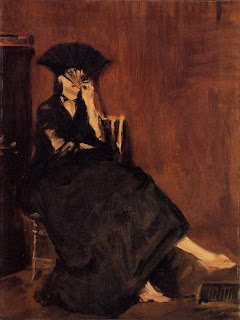It has taken me forever to work through Sue Roe’s
The Private Lives of the Impressionists, and I’m still not quite finished. I’ve had various obligations and nonrenewable library books that have consumed my time over the past three months. Hence,
Private Lives has had to sit on my nightstand for quite awhile. I’m really interested in the subject matter, though, and hope to finish the book soon.
Anyhow, I have read far enough in the book to learn more about the relationship between Manet and Berthe Morisot, a female Impressionist painter. Morisot posed in several of Manet’s portraits, and it is often thought that the two were romantically interested in each other (although Manet was already married and Morisot eventually became engaged to Manet’s brother). Manet’s painting on the left, The Balcony (1868-69) was the first painting for which Morisot posed (she is seated in the foreground). Since I am interested in this Manet/Morisot relationship, I was excited to see that today heidenkind mentioned an interesting article on this topic (see her fun post which “interviews” Manet).
The article, “Unmasking Manet’s Morisot” by Marni R. Kessler visually analyzes portraits of Morisot by Manet. Kessler points out that the “crucial significance of Manet’s depictions of Morisot lies in…continual shifting identity: [Morisot] looks different from canvas to canvas.”1 It is especially interesting to see how Morisot’s portraits morph over time, especially as Morisot’s relationship progressed with Manet’s brother. Morisot’s features continually become harsher in the paintings, and she is depicted with increasingly violent brushstrokes. Take a look at these following paintings, which are posted chronologically:
Manet, Le Repos (Portrait of Berthe Morisot), 1870
Manet, Berthe Morisot with a Bouquet of Flowers, 1872
Manet, Berthe Morisot with a Fan, 1872
Manet, Berthe Morisot with a Veil, 1872
Manet paints this veil so that it simultanously reflects lace, a skull, and even a beard.2 Not a very flattering portrait, is it?
Manet, Berthe Morisot in a Mourning Hat, 1874
This painting was created shortly after Morisot’s father died. Also, by this time, Morisot was engaged to Manet’s brother. Not surprisingly, Manet abruptly stopped painting Morisot after her marriage.
Pretty interesting, huh? It seems that the depictions of Morisot don’t reflect changes in her actual appearance too, since she also painted self-portraits at the time. Instead, one can visualize Manet’s frustration and sense of loss as Morisot becomes engaged to Manet’s brother. I would really recommend that you read Kessler’s detailed analysis of these paintings – they are quite fascinating.
This article explores a lot of other interesting ideas, such as Kessler’s argument that a sense of artistic rivalry is manifest in these same portraits: interestingly, Manet never chose to depict Morisot in the act of painting. Instead of a reference to her accomplishments as a painter, all of these portraits emphasize Morisot’s gender and femininity in one way or another.3
Anyhow, this is an interesting article, and I wholeheartedly recommend it.
1 Marni R. Kessler, “Unmasking Manet’s Morisot,” The Art Bulletin 81, no 3 (September 1999): 475.
2 Ibid., 482.
3 Ibid., 477-478.









